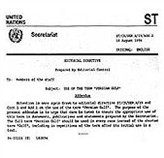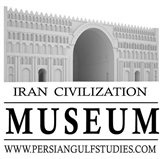Summary of Persian Gulf Studies
Persian Gulf due to its strategic position and being imbued with natural resources has been the center of attention of governments and nations from past era until today. And many sultans and kings have had views to its economic position from ancient times among which we can name Achaemenid and Parthian kings supporting commercial development in this region. The Parthian controlled two trade roads one of which was a trade way which spread along Forat and from Asia Minor and Syria and northern Beinonahrein towards Persian Gulf. (1)
Iran king, Darius ordered to create Suez canal for developing commerce in Iran so that commercial vessels could pass Persian and Red seas and get to Egypt and to the Mediterranean. In a remaining inscription from that era it can be read: “King Darius says: I am Persian and conquered Egypt from Persia and ordered to drill this canal and people go from Nile which flows in Egypt to a sea from Persia. This canal has been drilled and vessels sail as I command. As it was at my will.” (2)
As it’s been quoted in history, the Arsacid developed commerce and competed closely with Romans and transformed Fars Sea into a transit road. (3)
This progress continued in Sassanid era and Siraf port (around Boushehr) became a big commercial center and even in historical documents of China everywhere the names Pars, Fars, Parsua and Iran can explicitly and widely be seen and this shows existence of commercial ties. (4)
After Iran was conquered by Muslims, again Iranians were ahead of other middle east governments in sailing and the Arabs maintained sea trade arrangements with India and China and … . (5)
During history profiteer colonizers can also be seen in Iran who have been constantly struggling to obtain high position of Persian Gulf. One evident example was in Safavid era when Ottomans had started their invasion of Persian Gulf. And everyday added to navy forces and reinforced it and the Portuguese on the other side completely dominated this region in 16th century and clashed with Ottomans until finally in 1587 king Abbas with assistance of England repelled the Portuguese. And instead England gained a foothold in the region and the Dutch took possession of a share of Iran’s commerce by conquering Hormoz strait in 1033. This matter led to conflicts with England. It wasn’t long after that when French East India company was established in 1075 and another competitor was added. Of course it should be reminded that at time of Afsharian dynasty, King Nader managed to create navy force in Persian Gulf and bought several vessels from England and Netherlands. (6)
The Persian Gulf was invaded by colonizing countries more than ever before at time of Qajar dynasty; Specially English colonizer which deemed itself ruler of Persian Gulf and mindlessness of Qajar kings paved the way for illegal presence of England, France and Russia. Amir Kabir strived hard to form navy forces of Iran in Persian Gulf and Caspian Sea but his attempts failed due to hindrances of competitors.
Presence of aliens in Iran and obtaining interests continued until end of Second World War when Pahlavi Iran triumphed Persian Gulf with support of America and reinforcing its navy forces obtained control of Persian Gulf. But dependence of Iran on America didn’t last long and led to overthrowing of king’s dynasty. America’s deceptions led to disputes in region after Islamic revolution which was thoroughly revealed in form of imposing war by Iraq against Iran and exerting military and political pressures by America and its allies. Stimulating Persian Gulf margin countries, specially the small and dependant country of UAE today America and England intend to cause disorder in region and with the “Arabian Gulf” trick attempt to start mental war seek to exert pressures against Iran.
The case of unpleasant act of renaming Persian Gulf which in fact is an insult to identity and civilization of a nation and is followed by profiteering and being greedy of aliens has been formed in 1937 and now exists in ministry of foreign affairs of England. (7)
Based on this forged case the first person to forge explicitly the word “Persian Gulf” and use “Arabian Gulf” instead was a filthy English colonizer agent in Persian Gulf named “Lord Blegriu” who writes in his book: “Persian Gulf who Arabs now name it Arabian Gulf…” . He attempted to spread this made-up word among countries of Persian Gulf region especially Arabs. (8)
Historical name of Persian Gulf
Ancient geographers considered some roots in naming lands, seas, rivers, mountains and …; Such as names of most rivers being derived from color of waters, lands and … . Names of mountains is derived from similarity to other bodies and name of lakes and seas has followed a firmer origin and most of them were named after the name of country or land that was close to them or surrounded them; Like Mexico Gulf, Persian Gulf, China sea, India Ocean, Mazandaran (Caspian) sea and … . (9)
Southwestern part of Iran is Fars, the ancient residents of which were named “Parses” (Parsian) which name was changed and used by Greek as persay and two dynasties arose from this race (Sassanid and Achaemenid). Some researchers believe that Parsian are same as Parsua people who were residents of Orumia river (name of who has been inscribed in Assyrian epigraph) and went southward and settled down in land of “Pars”. (10) For this reason the sea neighboring this region was named Pars sea when none of today’s big and small were on Persian Gulf coasts and if they were, they were considered part of larger land of Iran. Even powerful countries of that time like Greece and Rome entered their vessels into Persian Gulf with Iranians’ permission. (11) Greeks called this sea “Pers”. (12)
Darius the great has noted this sea and has used the phrase “Dar aye tie hecha parsa abi” meaning Pars Sea which is obvious in his remaining inscription. (13)
The Arabs also know that this name (Persian Gulf) has been real name of this sea from long time ago. Reputable Arab geographers also new that from 1st centuries of Islam. Abelghasem Obeidollah Ebne Abdollah Mostowfi known as Ebne Khardazabe wrote in his book in 844-848 AD Persian Gulf: … Bahr Fars. Bahr Fars in Arabic means Persian sea. (15)
Masoudi another reputable Arab author in his valuable book, Moravvejozehb va Madan Jowhar, when talks of overall news of seas, has noted Persian Gulf as Persian sea (بحر الفارس). (16) Ebn Howghel, famous Arab explorer and reputable geographer quotes: “In 942 I left Baghdad intending to study about different countries and nations and to trade and travelled Islamic countries from east to west and I also studied works of precursors.” (17) He notes Persian Gulf as Bahr Fars (meaning Fars sea) in his famous book, Sorat Arz. Estakhri, expert Arab geographer and author of “Almasaalek va Almamaalek” again notes Fars sea. (18)
Abolfadaa, author of Taghvimolbaladaan, who enjoys a special place notes Fars sea and when describing boundaries of Fars he writes: “East limit of Fars is Khuzestan. All the west through to north is limits of Isfahan and mountains and southern limit of it is Fars sea … . (19)
In “Majamolbaladaan”, a famous book which all geographers deem it valid as a geographic encyclopedia, Persian Gulf has been noted as “Bahr Fars” (meaning Fars sea). (20)
Therefore what is deduced from historical texts and even Arab geographers have acknowledged is that “Persian Gulf” has belonged to Parsian and Iranians in eras of history and today Arabs with cooperation of America and England are in a futile attempt to destroy Iran’s historical and ancient ownership with huge revenue yielded from oil and pave the way for looting this sea more than ever.
Footnotes:
1. Mikhailovich Diakonov، Mikhail; History of ancients' Iran
2. Hamid Tousi Maraghei; Behistun Inscription, P.563
3. Iraj Afshar (Sistani); Historical Geography of Pars sea, P. 293
4. That same ,P.294
5. Krachkowski, Ignayolianowich; Historical geography writings in Islam world, P. 111
6. Iraj Afshar; The name of Persian Gulf , P. 41
7. Iraj Afshar (Sistani);That Same , P.138-139
8. Iraj Afshar ; That Same , P.64
9. Previous
10.Abbas Ghadyani; Comprehensive encyclopedia of history of Iran, P. 221
11.Abdol Hossein Nahchiri ;The Historical Geography of Cities , P.375
12.Iraj Afshar (Sistani); Historical Geography of Pars sea, P. 127
13.That same,P.118 & Hamid Tousi Maraghei; Behistun Inscription, P.563
14.Ibn Khordadbeh; Al Masālik w’al Mamālik (The Book of Roads and Kingdoms).
15.That same,P.233
16.Masudi ;Meadows of Gold and Mines of Gems( transliteration: Muruj adh-dhahab wa ma'adin al-jawhar),P. 166
17.Ibn Hawqal; The face of the Earth. (transliteration: Ṣūrat al-’Arḍ)
18.Abu Ishaq al Istakhri; The United Arab Republic, Ministry of Culture. 29
19.Abu'l-Fida;A Sketch of the Countries (transliteration: Taqwim al-Buldan),P. 367
20.Yaqut al-Hamawi;Dictionary of Countries"( transliteration: mu'jam al-buldan),P. 400










